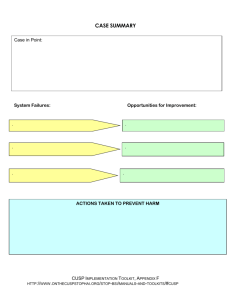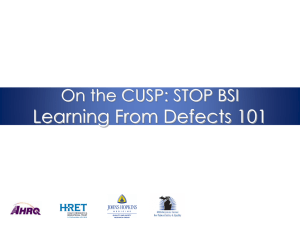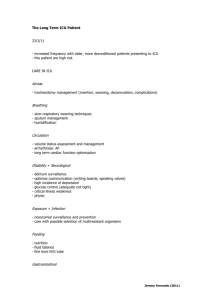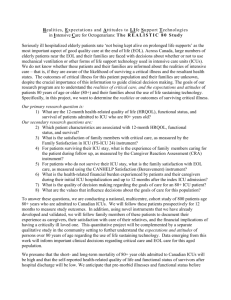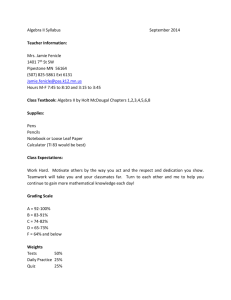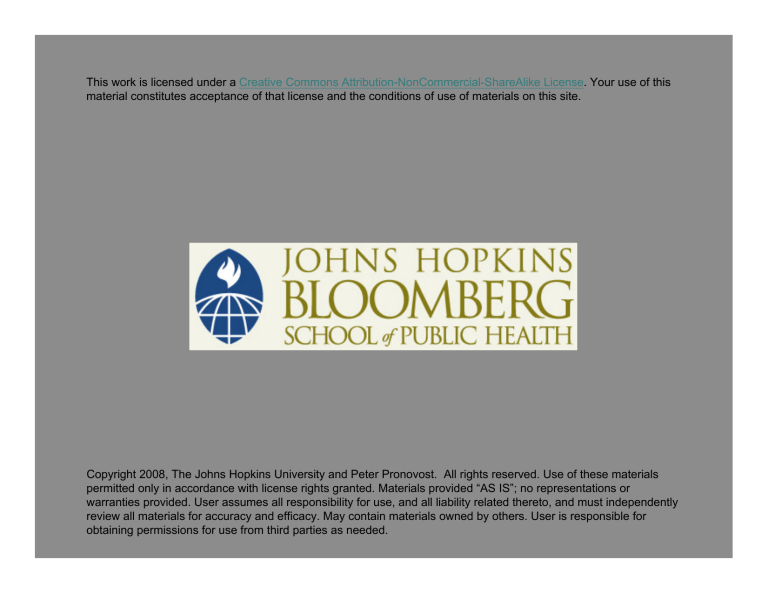
This work is licensed under a Creative Commons Attribution-NonCommercial-ShareAlike License. Your use of this
material constitutes acceptance of that license and the conditions of use of materials on this site.
Copyright 2008, The Johns Hopkins University and Peter Pronovost. All rights reserved. Use of these materials
permitted only in accordance with license rights granted. Materials provided “AS IS”; no representations or
warranties provided. User assumes all responsibility for use, and all liability related thereto, and must independently
review all materials for accuracy and efficacy. May contain materials owned by others. User is responsible for
obtaining permissions for use from third parties as needed.
Practical Tools to Improve
Patient Safety: Comprehensive UnitBased Safety Program (CUSP)
Peter Pronovost, MD, PhD,
Johns Hopkins University
Comprehensive Unit-Based Safety Program (CUSP)
1.
2.
3.
4.
5.
Safety culture assessment
Science of safety training
Staff identify safety hazards
Senior executive partnership
a. Learn from safety defects
b. Tools to improve
6. Safety culture reassessment
3
Pre-CUSP Work
Assemble a safety team, including . . .
− Project leader/unit champion (e.g., RN or MD leader)
− Nurse manager
− Physician champion
− Other integral members of unit (e.g., pharmacist, RT)
− Senior executive (e.g., CEO, dean, president)
Complete safety team contact list (form)
Read each step of CUSP before implementation
4
Science of Safety Training: Step 2
Purpose: explain patient safety problem, introduce
investigation of system defects, highlight how they can make
a difference
Process:
− Complete SAQ first
− Watch Josie King and Science of Safety videos
− Large group training more efficient
− Track staff trained with attendance sheet (form)
− Distribute staff safety assessment form (step 3) at end of
training
5
Staff Identify Defects: Step 3
Purpose: tap into expertise and knowledge of frontline
providers; empower and engage in safety
Process:
− Staff safety assessment survey (form—2 ques.)
− Collate and group responses into common defects (e.g.,
communication, patient falls)
− Other sources of defects; incident reports, liability claims,
M & M conferences
Results set agenda for step 4
Step is iterative
6
Senior Executive Partnership: Step 4
Purpose: connect senior management with frontline
providers; advocate for unit and remove barriers for
implementing improvements
Process:
− Preplan: project leader finds out number of units
implementing CUSP, number of senior executives
available—enough for each unit?
− Unit safety team meet and orient executive
7
Senior Executive Partnership: Step 4
−
−
−
−
−
Set up monthly safety rounds with executive (6 mos.)
Brief frontline providers about purpose of safety rounds
Safety rounds: discuss safety issues (step 3)—executive,
safety team and unit staff
Document safety issues discussed (form)
Identify and manage improvement projects (form)
8
Learning from Defects: Step 5a
Purpose: investigate why system(s) failed and implement
improvement efforts
Process:
− Identify safety defect
− Use How to Investigate Defect tool
− Investigate at least one defect per month
− Complete case summary form
− Share case summary (optional)
9
What Is a Defect?
Anything you do not want to have happen again
10
Sources of Defects
Adverse event reporting systems
Sentinel events
Claims data
Infection rates
Complications
Where is the next patient going to be harmed?
11
Key Aspects of Learning from Defects
Describe what happened
Identify why it happened
Define what you will do to reduce the chance it will recur
− Person, issue follow-up
12
James Reason Quote
“ Rather than being the main instigators of an
accident, operators tend to be the inheritors of
system defects. . . . Their part is that of adding the
final garnish to a lethal brew that has been long
in the cooking.”
— James Reason, Human Error (1990)
13
Safety tips:
• Label devices that work together to complete a procedure
• Rule: stock together devices needed to complete a task
Case Summary
CASE IN POINT: An African American male ≥ 65 years of age was admitted to a
cardiac surgical ICU in the early morning hours. The patient was status-post cardiac
surgery and on dialysis at the time of the incident. Within 2 hours of admission to the
ICU it was clear that the patient needed a transvenous pacing wire. The wire was
threaded using an IJ Cordis sheath, which is a stocked item in the ICU and standard
for PA caths, but not the right size for a transvenous pacing wire. The sheath that
matched the pacing wire was not stocked in this ICU since transvenous pacing wires
are used infrequently. The wire was threaded and placed in the ventricle and staff
soon realized that the sheath did not properly seal over the wire, thus introducing risk
of an air embolus. Since the wire was pacing the patient at 100%, there was no
possibility for removal at that time. To reduce the patient’s risk of embolus, the
bedside nurse and resident sealed the sheath using gauze and tape.
SYSTEM FAILURES:
Knowledge, skills, competence. Care providers lacked the knowledge
needed to match a transvenous pacing wire with appropriate sized
sheath.
OPPORTUNITIES for IMPROVEMENT:
Regular training and education, even if infrequently used,
of all devices and equipment.
Unit environment: availability of device. The appropriate size sheath for a
transvenous pacing wire was not a stocked device. Pacing wires and
matching sheaths packaged separately… increases complexity.
Infrequently used equipment/devices should still be
stocked in the ICU. Devices that must work together to
complete a procedure should be packaged together.
Medical equipment/device. There was apparently no label or mechanism
for warning the staff that the IJ Cordis sheath was too big for the
transvenous pacing wire.
Label wires and sheaths noting the appropriate partner for
this device.
ACTIONS TAKEN TO PREVENT HARM IN THIS CASE
The bedside nurse taped together the correct size catheter and wire that were stored in the supply cabinet. In addition, she
contacted central supply and requested that pacing wires and matching sheaths be packaged together.
14
Learning from Defects Mortality/Morbidity Conference
Select 1 or 2 meaningful cases
Invite everyone who touches the process, including
administrators
Summarize event
Identify hazardous systems
Close the Loop (issue, person, f/u)
Share what you learn
15
#5 “Errors Are Handled Appropriately in This ICU”
CSICU T2
80
70
60
50
40
30
CSICU T1
% of respondents within an ICU that agree
100
90
20
10
0
16
CSICU T2
100
90
80
70
60
50
40
30
20
10
0
CSICU T1
% of respondents within
an ICU that agree
#4 “I Would Feel Safe Being Treated Here As a Patient”
17
% of respondents within an ICU
reporting good safety climate
Safety Climate across CUSP/Michigan ICUs
100
90
80
70
60
50
40
30
20
10
0
WICU TIME 3
SICU TIME 3
WICU POST-CUSP
WICU PRE-CUSP
SICU PRE-CUSP
SICU POST-CUSP
18
% of respondents within an ICU
reporting good teamwork climate
Teamwork Climate across CUSP/Michigan ICUs
100
90
80
70
60
SICU
WICU
50
40
30
20
10
0
19
Teamwork Climate across Michigan ICUs
% of respondents within an ICU reporting
good teamwork climate
100
90
80
70
2004
2005
60
50
40
30
20
10
Change of 10 points or more is significant:
25 ICUs improved by 10 points or more,
9 ICUs got worse
0
20
Safety Climate across Michigan ICUs
% of respondents within an ICU
reporting good safety climate
100
90
80
70
2004
2005
60
50
40
30
20
10
0
Change of 10 points or more is significant:
31 ICUs improved by 10 points or more
7 ICUs got worse
21
Daily Goals
Who: rounding team, bedside nurse
What: discuss
− What needs to happen for patient to be discharged
− What work will be done today
− What the safety risks are
− Whether tubes, lines, or drains are to be removed
When: during rounds
How: stays with patient’s nurse
Notes Available
22
Percent Understanding Patient Care Goals
1
0.9
0.8
0.7
0.6
0.5
0.4
0.3
0.2
0.1
0
Implemented patient
goals sheet
Residents
Nurses
1
2
3
4
5
6
23
Impact on ICU Length of Stay
Daily goals
2
1.5
ICU LOS
1
0.5
0
Ju
ne
Ju
l
Au y
Se gu
pt st
em
b
Oc er
t
No obe
ve r
m
De be
ce r
m
b
Ja er
nu
a
Fe ry
br
ua
ry
M
ar
ch
Ap
ril
M
ay
Avgerage LOS (days)
2.5
654 new admissions: 7 million additional revenue
24
How to Use Goals?
Be explicit
Important questions
− What needs to be done for discharge?
− Safety risk?
− Scheduled labs?
Completed on rounds
Stays with bedside nurse
Modify to fit your hospital
25
Morning Briefing
Who: charge nurse, attending, resident
What: discuss
− What happened over night
− Who is coming and going
− What I am worried about during the day
When: pre-rounds each morning
How: evening charge nurse completes
Notes Available
26
Summary
Safety is a property of system
We need lenses to see the system
CUSP is a structured approach to learn from mistakes and
improve safety culture
Tools to learn from mistakes and improve culture
− How to investigate a defect
− Daily goals
− A.M. briefing
27
Task List
Create team
Educate staff on science of safety by reviewing a defect
Ask staff how next patient will be harmed
Obtain executive to adopt ICU
Create interdisciplinary forum to learn from defects
Pilot test daily goals and A.M. briefing
28





